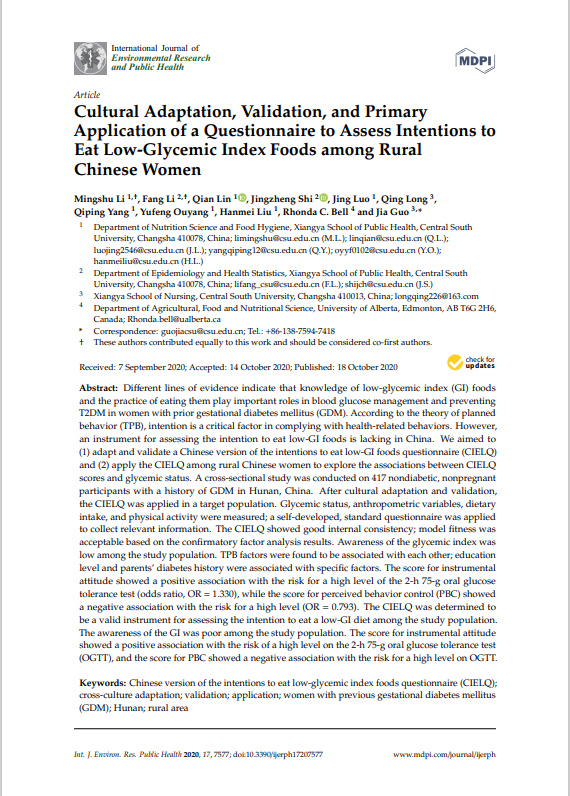Impact Factor:2.849
DOI number:10.3390/ijerph17207577
Affiliation of Author(s):中南大学
Journal:International journal of environmental research and public health
Place of Publication:瑞士
Key Words:Chinese version of the intentions to eat low-glycemic index foods questionnaire (CIELQ); Hunan; application; cross-culture adaptation; rural area; validation; women with previous gestational diabetes mellitus (GDM).
Abstract:Different lines of evidence indicate that knowledge of low-glycemic index (GI) foods and the practice of eating them play important roles in blood glucose management and preventing T2DM in women with prior gestational diabetes mellitus (GDM). According to the theory of planned behavior (TPB), intention is a critical factor in complying with health-related behaviors. However, an instrument for assessing the intention to eat low-GI foods is lacking in China. We aimed to (1) adapt and validate a Chinese version of the intentions to eat low-GI foods questionnaire (CIELQ) and (2) apply the CIELQ among rural Chinese women to explore the associations between CIELQ scores and glycemic status. A cross-sectional study was conducted on 417 nondiabetic, nonpregnant participants with a history of GDM in Hunan, China. After cultural adaptation and validation, the CIELQ was applied in a target population. Glycemic status, anthropometric variables, dietary intake, and physical activity were measured; a self-developed, standard questionnaire was applied to collect relevant information. The CIELQ showed good internal consistency; model fitness was acceptable based on the confirmatory factor analysis results. Awareness of the glycemic index was low among the study population. TPB factors were found to be associated with each other; education level and parents' diabetes history were associated with specific factors. The score for instrumental attitude showed a positive association with the risk for a high level of the 2-h 75-g oral glucose tolerance test (odds ratio, OR = 1.330), while the score for perceived behavior control (PBC) showed a negative association with the risk for a high level (OR = 0.793). The CIELQ was determined to be a valid instrument for assessing the intention to eat a low-GI diet among the study population. The awareness of the GI was poor among the study population. The score for instrumental attitude showed a positive association with the risk of a high level on the 2-h 75-g oral glucose tolerance test (OGTT), and the score for PBC showed a negative association with the risk for a high level on OGTT.
Note:Q1区
Co-author:Fang Li, Qian Lin, Jingzheng Shi, Jing Luo, Qing Long, Qiping Yang, Yufeng Ouyang, Hanmei Liu, Rhonda C Bell
First Author:Mingshu Li
Indexed by:Journal paper
Correspondence Author:郭佳
Discipline:护理学
Document Type:J
Volume:17
Issue:20
Page Number:7577
Translation or Not:no
Included Journals:SCI


